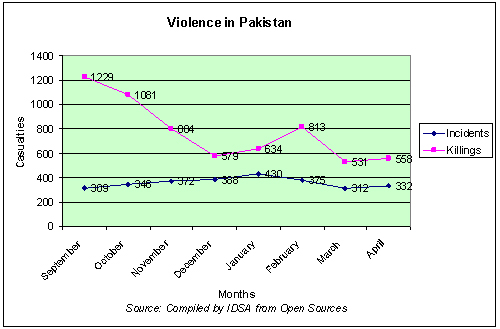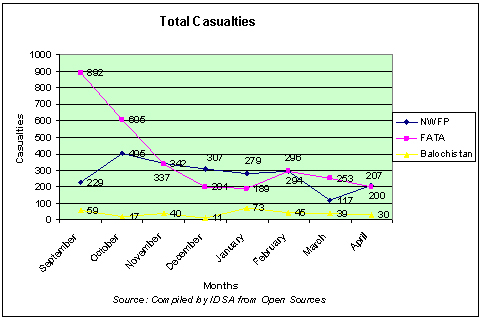- About us
- ABOUT MP-IDSA
- VISION STATEMENT
- CONFERENCE FACILITY
- EXECUTIVE COUNCIL
- Memorandum of Association: Rules and Regulations
- MP-IDSA NEWS
- DIRECTOR GENERAL
- INTERNATIONAL INTERACTIONS
- Fellowship rules
- VISITING FELLOWSHIPS PROGRAMME
- Deputy Director General
- INTERNSHIP PROGRAMME
- CONTACT US
- Former Presidents
- HUMAN RESOURCES
- JOBS
- Former Directors
- Prevention of Sexual Harassment
- CENTRES
- Events
- Library
- Publications
- Membership
IDSA COMMENT

Violence in Pakistan: Trend Analysis April 2009
More from the author
More from the author
April saw the foot soldiers of Taliban moving to Buner and Dir, after consolidating their position in Swat. The march of Taliban to Buner, which is separated from Islamabad just by the district of Haripur created a fear psychosis in the minds of the ruling elites in Islamabad. The shock and awe that Taliban had managed to create was clearly evident as the Pakistani parliament pushed through Nizam-e-Adl resolution, without refering it to any parliamentary committee on April 13.
The shock and awe that Taliban had managed to create was clearly evident as the Pakistani parliament pushed through Nizam-e-Adl resolution, without refering it to any parliamentary committee on April 13.
Faced with the prospects of being declared non-Muslim, the parliamentarians including women, who probably had the most to lose merely acquiesed to the proposal. Even MQM , which had been talking against the Taliban, chose the easier option of walking out rather than vote against the proposoal and risk being declared non-Muslim. An emboldened Taliban started talking about extending Nizam-e-Adl to the whole of Pakistan. Sufi Mohammad, the TNSM chief even called democracy and elections as unIslamic. Faced with strong pressure from the US, the Pakistan Army finally launched an offensive against Taliban in Buner and Dir districts of NWFP on April 26, 2009, which in effect marked an end of the Swat peace deal, which the provincial government of NWFP had signed with Sufi Mohammad.
Even during the period when the peace deal was in force, Taliban violence continued in other parts of NWFP, FATA and even Punjab. Terror incidents increased from 312 in March to 332 in April, leading to higher casualties. Operations launched by the security forces resulted in the number of militants killed increasing significantly from 165 in March to 203 in April. Similarly, the operations resulted in higher casualties for security forces as well; 83 security personnel were killed and 123 injured during the month as against 65 killed and 28 injured in March.
There were five (seven in March) suicide attacks by the militants in April, out of which two were triggered in NWFP, one in FATA, one in Punjab and one in Islamabad. These five attacks claimed 117 lives and maimed 220 as against 118 killed and 192 wounded in suicide attacks the previous month.
NWFP
Like in the previous three months, NWFP remained the most violent province in Pakistan and the “deal” did not really help in reducing the violence levels. 125 terror related incidents were recorded in April as against 103 in March. 207 people were killed and 109 others were inju
red in these incidents. As a result of the military operations in Malakand, the number of alleged ‘militants’ killed increased to 83 as against 54 in March. Similarly, 57 security personnel were killed and 72 injured as against 18 killed and 20 injured in March. There was large scale collateral damage; resulting in death of 67 civilians and destruction of large scale property and houses. This resulted in large scale migration of people from the affected areas to other parts of NWFP. A large number of houses and property was also destroyed in the crossfire.
During the month Taliban spread its influence to other parts of NWFP after consolidating its position in Swat through the peace deal. The militants carried out attacks in Hangu, Charsadda, Mardan, Kohat, Swabi, Buner and Lakki Marwat, Lower and Upper Dir etc. Consequently, Operation Toar Tander-I (Black Thunderstorm-I) was launched in the Maidan area of Lower Dir on April 26 and continued till the end of the month killing above 50 Taliban. Operations were also launched in Buner.
The month also witnessed proliferation of radical elements in the universities in the province. On April 14, the security forces arrested a terror suspect from a hostel in the Kohat University. On April 17, an encounter took place in Peshawar University Campus with two suspected suicide bombers, who despite attempt by the police to overpower them, managed to escape.
FATA
April 2009 saw an increase in violence in FATA, although the casualty figures dropped marginally. Incidents of violence were reported from all the seven agencies. Security forces launched aerial attacks on militant positions in Orakzai and Mohmand Agencies. There were five instances of drone attacks by the US in the region, which resulted in the death of 40 people and injuries to 20 others. Three of these attacks were in South Waziristan , while one each was in Orakzai and North Waziristan Agency. Most of those killed were alleged militants.
During the month members of the minority Sikh community in Orakzai Agency were asked to pay Rs. 40 million as jaziya. 38 members of the community were forced to flee their homes, which were subsequently destroyed when they failed to pay the amount. Sectarian violence continued between Bangash and Turi tribes in Kurram Agency. Many alleged spies of the security forces were killed by the militants. April also saw the peace deals signed with militants in North and South Waziristan agencies crumbling as there were some instances of targeted attacks on both the militants as well as security forces.
Balochistan
Like in the previous two month, the incidents of violence in Balochistan as well as casualties there decreased in April. 36 incidents were recorded as against 44 in the previous month. As a result, the number of casualties during the month was decreased form 39 in March to 30. Though the number of civilian casualties decreased from 35 in March to 22 in April, the number of casualties among security forces increased from three to eight in these months. No militant was killed or injured during April. It appears that militants in Balochistan enjoyed freedom of operation.
Apart form regular attacks against gas pipeline, power transmission lines and railway tracks, there was an increase in “grenade” attacks in Balochistan. Unlike militants who fight in groups against forces in other provinces, militants in Balochistan tend to focus on hit and run operations by a lone individual or by two people driving motorcycles. As a result, most people killed and injured were those targeted by Baloch nationalists. There were few attacks against the security forces, which included small scale ambushes and hurling of grenades, etc.
Other Areas
April 2009 saw Taliban making significant incursions into the Pakistani heartland of Punjab. It allied itself with various Sunni sectarian outfits to launch attacks on Shias. The security forces also tightened their vigil in Punjab and Sindh. According to former minister and head of Awami Muslim League (AML) Sheikh Rashid Ahmad there were as many as 300 suicide attackers present in the country and, if undetected, they could cause large-scale disaster. There were two suicide attacks during the month in Islamabad and Chakwal which resulted in the killing of 33 people and injuries to 152. The attack in Islamabad was targeted at the security forces, whereas in Chakwal, a Shia place of worship was targeted and leading to 24 deaths and injuries to 140 worshippers. The coming months will see more Taliban activities in Punjab and Sindh.
Casualty Figures in Violent Incidents in Pakistan

April 2009
Figure in parenthesis are the figures for March 2009